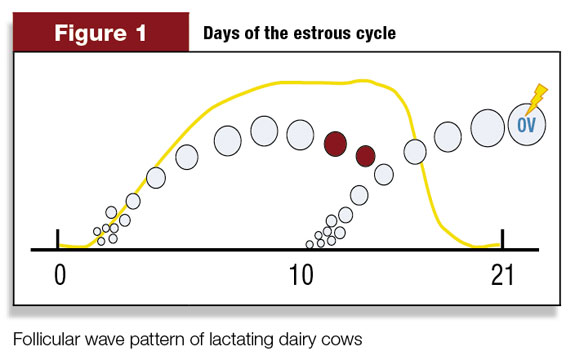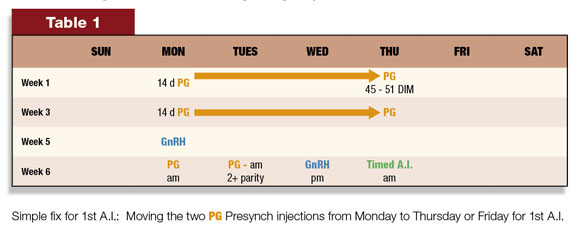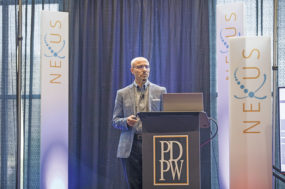TRENDING TOPIC ARTICLE: A.I. & BREEDING In this article, Michigan State University’s J. Richard Pursley explains how a simple adjustment of cycle days in a presynch/ovsynch program could have a dramatic effect on a herd’s fertility and a producer’s bottom line. to jump to the article.
Because this article was so popular, we asked Pursley,
Q. You describe the program that you outline as simple fix but a major change in mindset. How have you advised producers to reorganize their schedules to implement your injection plan?
He says, “I explain to them the benefits of how the change in the injection scheme affects stage of follicle development at the time of the start of Ovsynch and how that translates into greater numbers of pregnancies.”
ARTICLE
A minor logistical change in your Presynch/Ovsynch program moving from a calendar-based program to a more physiologically based program can dramatically impact conception rates for first A.I. and farm profit.
This article will describe why dairy cow fertility is a problem, how a relatively minor change from Presynch-14 to Presynch-10 or 11 can be implemented and how it can affect your bottom line.
The problem
Big strides have been made in the understanding of dairy cow fertility. The decline in fertility of high-producing dairy cows over the past 30 years spurred significant research in this area, some funded through the USDA.
Research indicates that progesterone is a key limiting factor in fertility of these cows. It appears that level of circulating progesterone is very important during the week prior to the final PG of Ovsynch (during growth of the ovulatory follicle).
The greater the concentrations of progesterone in circulation during this period, the greater chance for a pregnancy. It is not clear why, but levels of progesterone may impact the oocyte (egg) that is released at ovulation or other targets, including oviduct or uterus, for example.
Our research indicates that cows receiving first A.I. following a detected heat had about a 30 percent chance for pregnancy. Most published research indicates that heifers have about a 60 percent chance following first A.I.
Thus, as heifers transition to cows, the likelihood of pregnancy following a single A.I. is cut in half. Interestingly, heifers have approximately twice the amount of peak circulating concentrations of progesterone during the estrous cycle than lactating cows.
Solving the problem
So how do you enhance progesterone during the growth of the ovulatory follicle? Most of the work in our laboratory is focused on this question.
The bottom line is that cows need to be on Day 6 or 7 of the estrous cycle when the first GnRH of Ovsynch is administered. Cows on Day 6 or 7 of the estrous cycle have a very high probability of ovulating a follicle to the first GnRH of Ovsynch compared to other stages of the estrous cycle.
An ovulated follicle morphs into a corpus luteum (CL). In other words, the estrogen-producing follicle morphs into the progesterone- producing CL. Seven days later, at the time of the final PG of Ovsynch, this new CL increases progesterone concentrations at least 50 percent from about 3.5 ng per ml of progesterone in circulation to more than 5.0 ng per ml.
This significant increase appears to positively impact fertility. Another key advantage of controlling ovulation on Day 6 or 7 of the cycle is that cows will have an ovulatory follicle of consistent age and size. This appears to also enhance fertility. Yet, even in cows with same-age follicles, progesterone still has a positive impact on fertility.
So how do we ensure the best outcome from a Presynch/Ovsynch program? The second of two Presynch PG injections must be administered 10 or 11 days prior to the start of Ovsynch for cows to be on Day 6 or 7 of the cycle when the first GnRH of Ovsynch is administered.

In the classical Presynch-14 program, cows receive the second PG 14 days prior to the start of Ovsynch. Cows in this scenario are on Day 10 or 11 of the estrous cycle when the first GnRH of Ovsynch is administered.
This is a time when the first wave-dominant follicle becomes atretic (Figure 1) and a new follicular wave begins. An atretic follicle (shaded in red) will not respond to the GnRH, nor will a newly growing follicle.
Published data would indicate that cows have a 40 percent chance of ovulation at first GnRH with Presynch-14 compared to as much as an 80 percent chance with Presynch-11.
This means 100 percent more cows with Presynch-11 will have a new growing CL that will enhance progesterone and have ovulatory follicles of a more ideal age and size.
Simple fix, major change in mindset

Moving the two PG Presynch injections to Thursday or Friday if, for example, GnRH and PG of Ovsynch are on Mondays, seems relatively simple (Table 1).
Yet the logistics of accomplishing this on large dairies are not simple.
Thursday in most cases is the day of A.I., which takes significant time; Fridays are generally reserved for other weekly tasks and re-locking cows sometimes is not feasible.
A key change in mindset: All first-A.I. cows on this program must finish the program and receive either a timed-A.I. or A.I. to a detected estrus after the final PG of Ovsynch. It will be tough to not inseminate these first-A.I. cows to a detected estrus following the Presynch injections, but the rewards are a 50 percent increase in conception rates.
This immediately decreases the numbers of cows that are re-inseminated via detected estrus or Resynch, but the key is to ensure a high level of compliance if this new strategy is undertaken.
The bottom line: How this enhances profit
Calculating the economic advantage of this change can be done with a new ‘repro’ calculator found online. Click here for more information.
Drs. Victor Cabrerra and Julio Giodorno, UW – Madison, developed this calculator so that dairy producers, veterinarians and consultants can calculate advantages and disadvantages of reproductive management changes on-farm using farm inputs.
We utilized data from our studies to estimate the change of administering Presynch PG injections from Monday to Thursday or Friday would enhance profit 22 cents per cow per day or about $82,000 per year for a 1,000-cow dairy. The savings come primarily from the costs of re-inseminations and fewer pregnancy diagnoses.
The assumptions we made were a 14 percent point difference in conception rate in Presynch-10 or 11 vs. Presynch-14 (45 vs. 31 percent) for first-A.I. with conception rates from two or more inseminations the same. PD
Click here to email an editor for references which have been omitted due to space.
J. Richard Pursleyis a professor of bovine reproductive management with Michigan State University. Email J. Richard Pursley.







